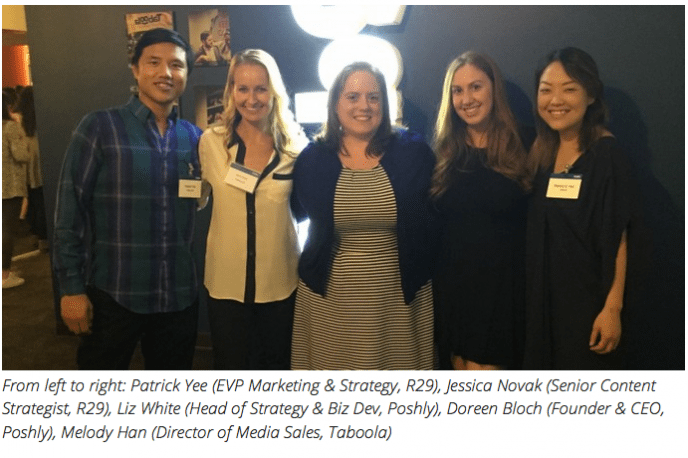Earlier this month, we hosted our latest Taboola Talks event around the theme of “Data Never Goes Out of Style.” A roomful of attendees gathered at Taboola’s global headquarters in New York City to hear from Jessica Novak, Senior Content Strategist at Refinery29, and Liz White, Head of Strategy and Development at Poshly.
The discussion revolved around both the opportunities and pain points of incorporating data-driven strategies into marketing and editorial workflows. Novak and White are enmeshed in these transitions at their respective companies, which have each carved out a valuable niche within the competitive digital media landscape.
Refinery29’s scientific approach to audience development (supported in part by Taboola Newsroom), paired with a distinctive editorial voice, have built it into the largest independent fashion and style website in the US. Poshly’s growing and buzz-worthy online platform hosts engaging questionnaires that help beauty lovers discover new products and unlock personalized giveaways.
Below are some of the key takeaways from the evening’s conversation, lessons that can be applied to both publishers and marketers as they experiment around the intersection of data science and content.
Brand Is the Key Differentiator
In recent years, the power of social amplification has allowed new sites to scale overnight. Equipped with real-time analytic tools and A/B testing methods, digital upstarts can effectively compete with established media brands in the social stream. “Scale has become commoditized,” Novak told the audience. The implication: brand matters more than ever as a means of standing out amongst the crowd.
Driving Engagement With New Formats
Many online media companies have begun differentiating themselves by innovating around new digital formats. White discussed how Poshly quizzes have established powerful new relationships with consumers, leading to average engagement times of over six minutes, and sessions where users willingly answer hundreds of questions, some of which are quite personal. While many established media companies remain stuck in analog mindsets, digital media players are exploring the full potential of the web’s interactive possibilities.
Defining Success in a Sea of Data
Online media companies today have unprecedented insight into their audiences. Sophisticated metrics such as day-parting and on-site navigation create a real-time story about how audiences consume content. Still, many editorial and marketing teams remain perplexed over the best ways to measure success.
 Novak and White spoke to the importance of stories having a life outside the site. In many ways, social media shares are becoming a more important metric than page views, but publishers still want visitors clicking through to their own sites. Recently, Novak wrote about the tension between “engineering a story that is both shareable and clicky,” a challenge that Refinery29 has measured through the visits-to-shares ratio (e.g. how many actual page visits does a social share generate).
Novak and White spoke to the importance of stories having a life outside the site. In many ways, social media shares are becoming a more important metric than page views, but publishers still want visitors clicking through to their own sites. Recently, Novak wrote about the tension between “engineering a story that is both shareable and clicky,” a challenge that Refinery29 has measured through the visits-to-shares ratio (e.g. how many actual page visits does a social share generate).
Such insights are not only valuable to publishers, but also to marketers that are hoping to reach high-quality audiences across the web. The success stories of Refinery29 and Poshly show how data-driven strategies can grow audience, on-site engagement, and value to potential advertisers. Although the data is constantly changing, the right strategy can make sense of the noise and provide a path forward.
